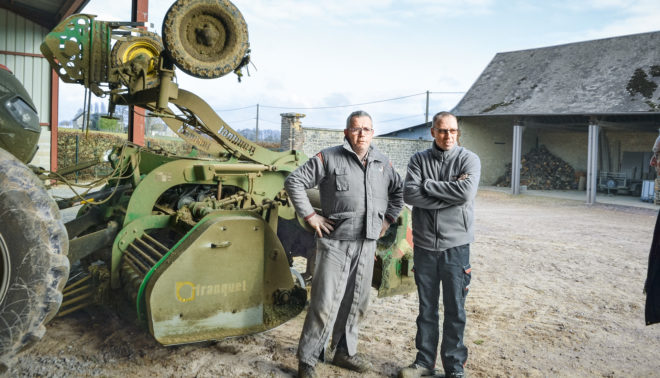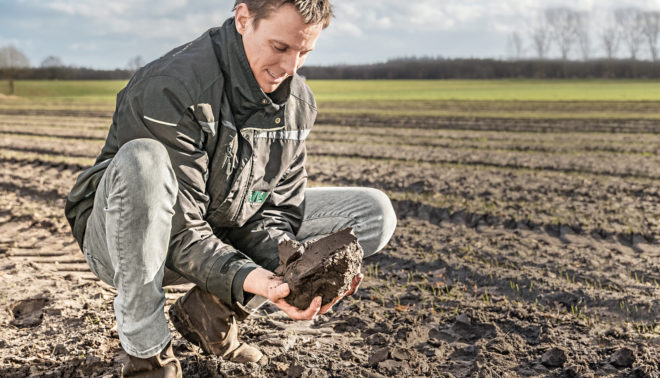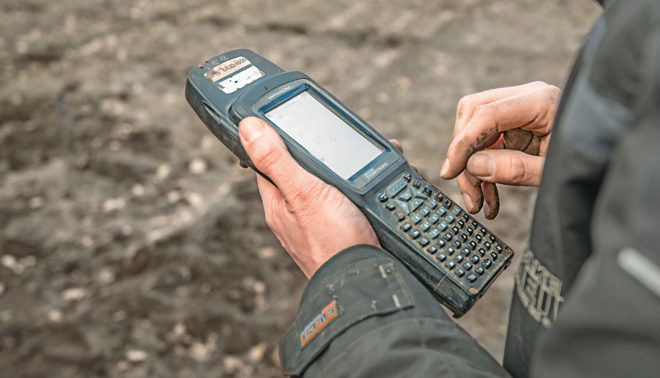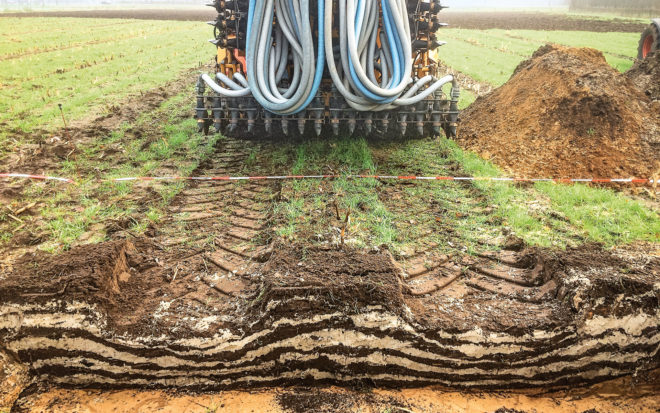At the end of November it is bitterly cold in this corner of the French département Aisne. Frédéric Sabreja, sugar beet grower, inspects the field. The weather is dry – hopefully it will remain so. “Last year we finished harvesting the beets in catastrophic wet conditions,” he recalls. “The trailers were buried to their axles in mud. They left such ruts that while ploughing a few days later, the tractor almost bottomed out.”
Similar conditions in recent years are a concern to members of the machinery co-operative Cuma (Co-opérative d’utilisation de matériel agricole) of Chalandry, of which Mr Sabreja is president. It affects both the soil structure and crop yields, notes his colleague Nicolas Mallèvre, who accompanies him that day on a tour of their fields. “Even if it’s not extreme compaction, we see the yield difference: Wheat after rapeseed yields 8-9t/ha, compared to 5t/ha after sugar beet. The later sowing after beets does not account for all of that difference.”
When to harvest?
Compaction issues are increasingly worrying producers in the North of France, especially with more frequent weather hazards, on naturally sensitive soils and with crops where exceptionally heavy machinery is involved, such as sugar beet and potatoes. However, the problem does not stop at the borders. The Netherlands, Germany, Austria: On a global scale, Europe as a continent has the biggest soil structure problems in the world.
“When 70t machines are working on sandy silt soils in heavy, wet conditions, that scares me,” says Mr Mallèvre. “A sugar beet harvester can compact the soil down to a depth of 1m. Earthworms had better have strong shoulders to unpack that!” These concerns are shared by other members of the Cuma co-operative, particularly given the end of sugar beet quotas. The 20% increase in local sugar refinery production and the resulting extended harvest schedules make it increasingly difficult to control harvesting conditions. So in 2017 the Cuma members decided to invest.
How far does it go down?
“We switched from contracting self-propelled beet harvesters on our 130ha of sugar beet to using a tractor with a front attachment to cut the foliage and a drawn beet harvester,” reveals Mr Sabreja. “This allows us both to reduce the weight on the soil and, since we own the equipment, to harvest in the best possible conditions.” The tractor-harvester combination has a net weight of 17t and Ultraflex tyres are inflated to 1.5 bar to spread the load. Having already adopted precision technologies like auto guidance and section-controlled application, members are now thinking about switching to remote tyre inflation systems.
“The number of axles is directly related to the depth of compaction, so we try to have as many as possible on the machine’s chassis,” notes Mr Sabreja. In addition, two rows of beets are sacrificed during sowing to allow for wide wheels to pass through.
“We do compact the soil, but try to stay as shallow as possible,” says Mr Mallèvre, pointing at the beautiful beet field that stretches behind him. In other words: Compaction is linked to so many variables that it can’t always be avoided. It is therefore more a question of controlling the risk. “If you compact deeper than 30cm, it’s too late. Mechanical action is ineffective: Only deep frost, drought, or time will enable the structure to improve again.”
We need to optimise as much as we can, to make farm operations sustainable.
Frédéric Sabreja
Cuma’s investment in the new harvesting system was logical – but the co-operative still needs to stay economically viable. The increase in beet production has been accompanied by falling sugar prices, while operating costs keep increasing. “Five years ago, we made €500/t (£438/t)”, says Mr Sabreja. “Today, we make €350/t (£306/t). There is no room for error: We need to optimise as much as we can, to make the farm operations sustainable.”
Fellow farmers are generally well aware of the risks of compaction, he adds. But, for the time being, many do not see avoiding compaction as a way to increase yields. However, Mr Sabreja expects this issue to become more prominent in the years to come. “I think the impact is not yet noticeable enough.”
Soil compaction in a nutshell
What happens in compacted soil? The diminishing size of the pores and cavities begins to adversely affect the exchange of air and water as well as plant rooting. In the absence of a vertical pore system, soil respiration (O2 intake and CO2 removal) is no longer guaranteed, and water tends to stay on the surface. When there is an air capacity of less than 10% or a hydraulic conductivity of less than 10cm a day, the oxygen deficiency will impact the micro-organisms and thus the formation of humus. At the same time, plant roots find it more difficult to access nutrients, which ultimately hampers yield.
Source: Prof Dr Rainer Horn. Read the whole interview here.
How severe is it?
350 km to the North, Louis Claessens, contractor in the Dutch village of Heino, describes the situation in almost identical terms. “The problem: Compaction is not something you see. As contractors, we leave the land nice and flat, which means it is impossible to see tracks that might have developed below the surface. But the soil has actually become so compacted that water cannot escape.”
Passionate about agronomy, Mr Claessens purchased the contracting business ‘Volkerink Heino’ in 2009. It was a difficult time to start: The aftermath of the 2008 financial crisis was still being felt, and the risk was significant. Hence the idea of differentiating himself with services focused on soil analysis and preservation. “My strategy is to fully utilise the potential of the clients’ production system. When they make money, so do we.”
In order to show his clients how serious the risk of soil compaction is, he recently organised a field demonstration, running 14 tests with different types of machines, chassis and tyres. “I wanted to visually demonstrate the impact that the wheel pressure has on the soil. Here, dairy farms do not care very much about soil quality.”
The weight of the machine does not necessarily have a negative impact on the soil.
Louis Claessens
At Volkerink Heino, reducing potential soil compaction drives each investment decision. The Van der Molen eight-wheeled chassis was installed on the 16m3 slurry tanker as well as on one of the trailers. Tyre pressures are set at one bar and the load at the wheel remains below the 3t level. Mr Claessens also uses a plough that allows the tractor to remain on the unploughed surface. “In terms of compaction, contractors bear the bulk of the responsibility,” he says. “It’s up to us to do something.”
One thing is certain: Preventing compaction will be more of an issue in the years to come, against a backdrop of increasing machinery weights. “However, the weight of the machine does not necessarily have to have a negative impact,” says Mr Claessens. “Everything comes down to weight per wheel: It is better to carry 16m3 on eight wheels than 10m3 on two.”
Technical innovations are under way which, coupled with existing precision technologies, should help farmers and contractors to apply methods which allow the soil to breathe, and the plants to take root properly.
Identifying compaction
So how do you identify compaction? According to soil expert Philip Wright, farmers should first look for areas where the grass or crop is performing badly – is it lying wet or yellowing under stress? “Having identified problem areas, dig a hole in a good area of the field to get a feel for what the soil structure should be like, and then dig in the bad areas – you’ll be able to feel and see the difference straight away.” Dig a series of holes to at least 1.5-2 spade depths, then prise off some soil on a non-smeared face. It should break away vertically; if it fractures into horizontal slabs that’s an indication of compacted layers. Look at the moisture in the soil profile, he adds. If there is a wet layer over a dry layer, water isn’t getting through. Also check the soil colour and smell, presence of worms, and root growth. Are the roots growing right down or reaching a layer and then stopping? All of this will help to identify the level and depth of compaction, so you can decide how to deal with it.
Alleviating compaction
Crop roots can support and improve soil structure – and dry or frosty weather can offer natural improvement through shrinking and cracking, says Mr Wright. “There is a temptation to go in with a deep subsoiler or plough, but that will cost more in fuel, disrupt the natural soil structure and potentially do more damage. You need to identify the limiting factor in the soil and do just enough to alleviate it – use the metal just enough to allow the roots to do the rest of the job.”










